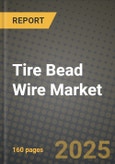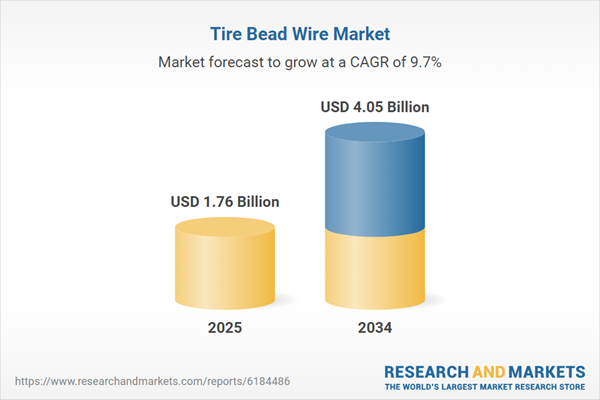Tire Bead Wire Market
Tire bead wire is a high-carbon, brass-plated steel wire used to anchor the tire to the rim, maintain bead geometry under load, and enable uniform tire seating during inflation and service. It is engineered for tensile strength, fatigue resistance, adhesion to rubber, dimensional precision, and corrosion protection - properties that directly influence tire durability, uniformity, and safety. Demand tracks global tire production across passenger cars, light trucks, commercial vehicles, two-wheelers, off-highway and specialty tires, with replacement and OEM cycles both relevant. Key trends include micro-alloying and process controls to lift strength-to-diameter ratios; tighter ovality and winding tolerances for automated tire building; enhanced brass plating chemistries for stable rubber adhesion; and in-line surface inspection with digital quality records. Sustainability considerations span energy-efficient wire drawing, plating bath management, and scrap recovery from steel cords. Competitive dynamics feature integrated steelmakers with wire rod to finished wire capability, specialized bead wire producers, and regional players close to tire plants to minimize logistics risk. Differentiation centers on melt quality and cleanliness, surface finish, residual torsion control, spool/winding stability at high speeds, and consistent adhesion after aging. Challenges include input cost volatility (wire rod, zinc), maintaining plating bath stability at scale, ensuring uniformity across multi-site production, and qualifying to individual tire makers’ specifications, which can be exacting and proprietary. As tire manufacturers automate and consolidate platforms, suppliers that combine metallurgy excellence with process analytics, rapid changeovers, and collaborative R&D on adhesion and fatigue life are best positioned to win long-term supply agreements.Tire Bead Wire Market Key Insights
- Tight linkage to tire mix. Shifts toward higher-load, higher-speed, and low-rolling-resistance tires raise tensile and adhesion requirements; bead wire must support stiffer sidewalls and compact bead geometries without compromising mountability.
- Metallurgy is decisive. Clean steel, controlled pearlite, micro-alloying, and fine drawing schedules deliver high strength with ductility; fracture toughness and residual stress management improve bend fatigue at the splice.
- Plating chemistry stability. Brass composition, thickness uniformity, and intermetallic growth control ensure consistent rubber adhesion across cure cycles and aging; bath analytics and replenishment models reduce drift.
- Dimensional precision under automation. Low ovality, exact diameters, and tight winding enable high-speed tire building with fewer breaks; consistent cast/helix and residual torsion reduce machine stoppages.
- Advanced inspection and traceability. Eddy current, laser gauges, and vision systems feed SPC dashboards; coil-level genealogy and digital certificates accelerate audits and PPAP approvals.
- Form factors expand. Beyond single-wire beads, strand and cable designs address large OTR and truck tires, balancing flexibility, hoop strength, and splice quality.
- Supply chain proximity matters. Locating near tire factories cuts lead times and damage risk; VMI, consignment stock, and just-in-time deliveries stabilize tire plant uptime.
- Sustainability and compliance. Energy-efficient drawing, closed-loop water and plating, and responsible zinc management support OEM ESG goals; scrap return programs improve circularity.
- Cost management levers. Wire-rod sourcing strategies, die life optimization, and yield improvement on drawing and plating offset commodity volatility; standardized spools ease logistics.
- Co-engineering wins awards. Joint trials on adhesion promoters, bead apex compounds, and cure profiles produce measurable uniformity gains, tying suppliers into multi-year platform contracts.
Tire Bead Wire Market Reginal Analysis
North America
Demand is anchored by replacement tires and regional OEM assembly, with strong requirements for uniformity, adhesion after aging, and robust spool logistics to high-automation tire plants. Buyers emphasize supply resilience, PPAP documentation, and rapid technical support for process deviations. Sustainability reporting and safety audits influence vendor selection, while proximity and VMI programs are valued.Europe
Stringent quality and regulatory standards, including OEM-specific specs for high-speed and EV-ready tires, prioritize wire cleanliness, plating stability, and dimensional precision. Tire makers favor suppliers with advanced SPC, digital traceability, and documented environmental controls. Localization within the EU and flexible production scheduling help manage model mix and seasonality.Asia-Pacific
The largest tire manufacturing base spans value to premium segments. Global and regional bead wire producers compete on cost, scale, and qualification speed. China, India, and Southeast Asia drive volume in PCR/2W, while Japan and Korea emphasize high-performance and uniformity. Close-coupled supply nodes, rapid changeovers, and technical service teams are critical differentiators.Middle East & Africa
Growing tire manufacturing and distribution hubs support demand for cost-effective yet reliable bead wire, with emphasis on consistent adhesion and corrosion resistance in hot, saline, and dusty environments. Free-zone logistics and regional service partnerships help reduce lead times; OEM tenders weigh supplier stability and documentation quality.South & Central America
Regional tire plants serving domestic and export markets prioritize predictable deliveries, coil integrity, and responsive support for line issues. Budget sensitivity favors efficient drawing and plating operations with strong yield control. Partners that offer consignment stock, rapid replacement for breakages, and training on handling and splice practices gain share.Tire Bead Wire Market Segmentation
By Grade
- High Tensile Strength
- Regular Tensile Strength
By Type
- Radial tires
- Bias tires
By Application
- Automotive tires
- Motorcycle tires
- Truck tires
- Others
Key Market players
Bekaert, Kiswire, Hyosung, Bridgestone (internal), Michelin (internal), Tata Steel (Steelcord), ArcelorMittal (steel cord), Pirelli (internal), Shougang Concord, Zhejiang Tianlun, Henan Hengxing, Rajratan Global Wire, Heibei Wire, WireCo WorldGroupTire Bead Wire Market Analytics
The report employs rigorous tools, including Porter’s Five Forces, value chain mapping, and scenario-based modelling, to assess supply-demand dynamics. Cross-sector influences from parent, derived, and substitute markets are evaluated to identify risks and opportunities. Trade and pricing analytics provide an up-to-date view of international flows, including leading exporters, importers, and regional price trends.Macroeconomic indicators, policy frameworks such as carbon pricing and energy security strategies, and evolving consumer behaviour are considered in forecasting scenarios. Recent deal flows, partnerships, and technology innovations are incorporated to assess their impact on future market performance.
Tire Bead Wire Market Competitive Intelligence
The competitive landscape is mapped through proprietary frameworks, profiling leading companies with details on business models, product portfolios, financial performance, and strategic initiatives. Key developments such as mergers & acquisitions, technology collaborations, investment inflows, and regional expansions are analyzed for their competitive impact. The report also identifies emerging players and innovative startups contributing to market disruption.Regional insights highlight the most promising investment destinations, regulatory landscapes, and evolving partnerships across energy and industrial corridors.
Countries Covered
- North America - Tire Bead Wire market data and outlook to 2034
- United States
- Canada
- Mexico
- Europe - Tire Bead Wire market data and outlook to 2034
- Germany
- United Kingdom
- France
- Italy
- Spain
- BeNeLux
- Russia
- Sweden
- Asia-Pacific - Tire Bead Wire market data and outlook to 2034
- China
- Japan
- India
- South Korea
- Australia
- Indonesia
- Malaysia
- Vietnam
- Middle East and Africa - Tire Bead Wire market data and outlook to 2034
- Saudi Arabia
- South Africa
- Iran
- UAE
- Egypt
- South and Central America - Tire Bead Wire market data and outlook to 2034
- Brazil
- Argentina
- Chile
- Peru
Research Methodology
This study combines primary inputs from industry experts across the Tire Bead Wire value chain with secondary data from associations, government publications, trade databases, and company disclosures. Proprietary modeling techniques, including data triangulation, statistical correlation, and scenario planning, are applied to deliver reliable market sizing and forecasting.Key Questions Addressed
- What is the current and forecast market size of the Tire Bead Wire industry at global, regional, and country levels?
- Which types, applications, and technologies present the highest growth potential?
- How are supply chains adapting to geopolitical and economic shocks?
- What role do policy frameworks, trade flows, and sustainability targets play in shaping demand?
- Who are the leading players, and how are their strategies evolving in the face of global uncertainty?
- Which regional “hotspots” and customer segments will outpace the market, and what go-to-market and partnership models best support entry and expansion?
- Where are the most investable opportunities - across technology roadmaps, sustainability-linked innovation, and M&A - and what is the best segment to invest over the next 3-5 years?
Your Key Takeaways from the Tire Bead Wire Market Report
- Global Tire Bead Wire market size and growth projections (CAGR), 2024-2034
- Impact of Russia-Ukraine, Israel-Palestine, and Hamas conflicts on Tire Bead Wire trade, costs, and supply chains
- Tire Bead Wire market size, share, and outlook across 5 regions and 27 countries, 2023-2034
- Tire Bead Wire market size, CAGR, and market share of key products, applications, and end-user verticals, 2023-2034
- Short- and long-term Tire Bead Wire market trends, drivers, restraints, and opportunities
- Porter’s Five Forces analysis, technological developments, and Tire Bead Wire supply chain analysis
- Tire Bead Wire trade analysis, Tire Bead Wire market price analysis, and Tire Bead Wire supply/demand dynamics
- Profiles of 5 leading companies - overview, key strategies, financials, and products
- Latest Tire Bead Wire market news and developments
Additional Support
With the purchase of this report, you will receive:- An updated PDF report and an MS Excel data workbook containing all market tables and figures for easy analysis.
- 7-day post-sale analyst support for clarifications and in-scope supplementary data, ensuring the deliverable aligns precisely with your requirements.
- Complimentary report update to incorporate the latest available data and the impact of recent market developments.
This product will be delivered within 1-3 business days.
Table of Contents
Companies Mentioned
- Bekaert
- Kiswire
- Hyosung
- Bridgestone (internal)
- Michelin (internal)
- Tata Steel (Steelcord)
- ArcelorMittal (steel cord)
- Pirelli (internal)
- Shougang Concord
- Zhejiang Tianlun
- Henan Hengxing
- Rajratan Global Wire
- Heibei Wire
- WireCo WorldGroup
Table Information
| Report Attribute | Details |
|---|---|
| No. of Pages | 160 |
| Published | November 2025 |
| Forecast Period | 2025 - 2034 |
| Estimated Market Value ( USD | $ 1.76 Billion |
| Forecasted Market Value ( USD | $ 4.05 Billion |
| Compound Annual Growth Rate | 9.7% |
| Regions Covered | Global |
| No. of Companies Mentioned | 14 |









